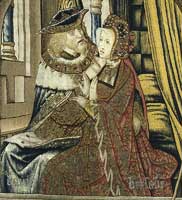 David
and Bathsheba, or in the French as our title shows, David et Bethsabée,
is a set of ten tapestries that are currently hanging in France, at the
Musée
National de la Renaissance at the Château d'Écouen. They
are not the only set of tapestries with that name, but these are considered
the finest. These tapestries were originally made in Brussels. The original
cartoon the tapestry artists worked from are probably from the artist
"Jean de Bruxelles, a Brabant artist in the service of the dukes
of Burgundy." The items within the tapestries helped to date them
to around c. 1510-1515. There are two possible owners who might have commissioned
these tapestries, one being "Margaret of Austria, Regent of the Netherlands
and guardian of her nephew Charles V" and the other "Henry VIII
of England in which the Venetian ambassador admired, in 1527, a costly
tapestry representing the story of David."
David
and Bathsheba, or in the French as our title shows, David et Bethsabée,
is a set of ten tapestries that are currently hanging in France, at the
Musée
National de la Renaissance at the Château d'Écouen. They
are not the only set of tapestries with that name, but these are considered
the finest. These tapestries were originally made in Brussels. The original
cartoon the tapestry artists worked from are probably from the artist
"Jean de Bruxelles, a Brabant artist in the service of the dukes
of Burgundy." The items within the tapestries helped to date them
to around c. 1510-1515. There are two possible owners who might have commissioned
these tapestries, one being "Margaret of Austria, Regent of the Netherlands
and guardian of her nephew Charles V" and the other "Henry VIII
of England in which the Venetian ambassador admired, in 1527, a costly
tapestry representing the story of David."
My interest in these tapestries is for the clothing worn by the people depicted in the tapestry. There are few images from the early part of the 16th century, so this helps me to understand the variety of clothing worn by the courtiers of the period. Most likely the fashions shown are Flemish, but I see among the odd headdresses and unusual gowns, the usual fashions seen in Northern Europe during this period including some outdated fashions, which gives a seemingly greater variety in fashion than is usually depicted in other images I have collected.
I turned to the book David & Bethsabée: Un Chef-D'oeuvre De La Tapisserie À La Renaissance by Delmarcel and Yvan for the scans. My research focus is on the clothing of the people, so I did not scan the entire book. I chose to focus the images only to the people (mostly women), and not the military scenes with pavillions, or other items seen in the tapestries unless they were in the middle of items I wanted to keep. I skipped tapestries that were military scenes with few to no women in it. I highly recommend getting a copy of this book to look at the images, and if you understand French, to read the discussion. As my understanding of French is rusty, I did not do that except in the most basic sense.
The images I share have title pages, and those titles were translated from the French by Google Translate, with some clarifications. The images within each tapestry are roughly ordered from from left to right, and top to bottom.
The images that show up initially will be small, to fit your browser window. At the bottom of each image is an Info bar with text description of each image. On the right hand side of the Info bar is a down arrow icon. Click on that icon to create a new image page with a larger sized image (max 1,000 pixels).
Click here to view David et Bethsabée images.
I do not have images that show an entire tapestry. The Met Museum now has a free pdf that shows all 10 tapestries in black & white, with information about them in English. Some full images can be found at wikimedia commons here. Bridgeman Art has them available to download for a fee. More images are linked below.
Other photos of this set by other photographers, or other David & Bathsheba tapestries:
- A few full D&B images at Wikimedia Commons
- Several photos of the David et Bethsabée details, starting from this page (click next for more).
- A Flickr set of some of the tapestries, shown in situ in the museum.
- Another Flickr set of the tapestries.
- Brussels 1530 - A different David and Bathsheba tapestry
Delmarcel, Guy, and Yvan Maes. David & Bethsabée: Un Chef-D'oeuvre De La Tapisserie À La Renaissance. Paris: RMN, 2008. Print. ISBN 271185339X
Home
Kimiko Small Designs
Joan Silvertoppe's SCA Resumé
Warderobe Accounts
Brodyworke Accounts
Scriptor Arts Folium
Tudor Research
Workshops & Articles
Inspiration Gallery
Largesse
Favorite Links
About Me
Contact Me
http://www.kimiko1.com
Entire website, graphics, and text (unless otherwise stated)
© 2003-2013 Kimiko Small, All Rights Reserved


